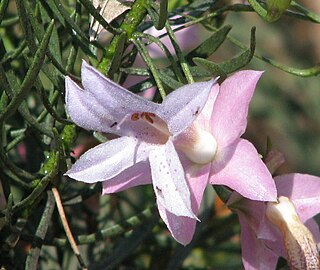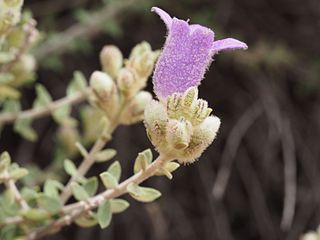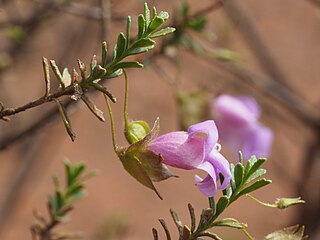
Eremophila abietina, also known as spotted poverty bush, is a plant in the figwort family, Scrophulariaceae and is endemic to a few arid areas of Western Australia. It is a stiff, upright, compact and very sticky shrub with distinctive, dark bluish-green leaves and pale coloured flowers spotted purple.

Eremophila cuneifolia, commonly known as pinyuru, is a flowering plant in the figwort family, Scrophulariaceae and is endemic to the north-west of Western Australia. It is a spreading, sticky shrub with wedge-shaped leaves, coloured sepals and usually deep purple flowers.

Eremophila mackinlayi, commonly known as desert pride, is a flowering plant in the figwort family, Scrophulariaceae and is endemic to Western Australia. It is a shrub with its branches and leaves covered with a thick layer of yellow to grey hairs, mostly egg-shaped leaves and deep lilac-coloured to purple flowers. It is most closely related to E. strongylophylla and E. hygrophana and sometimes occurs in the same areas as these species.

Eremophila citrina is a flowering plant in the figwort family, Scrophulariaceae and is endemic to the centre of Western Australia. It is a dense, rounded shrub with yellow new growth, crowded leaves and lilac-coloured to light purple flowers.
Eremophila compacta, commonly known as compact poverty bush, is a flowering plant in the figwort family, Scrophulariaceae and is endemic to the central west of Western Australia. There are two distinct subspecies differing in their growth habit but both have grey leaves due to a covering of white or grey hairs, and purple to blue, rarely white flowers.
Eremophila fasciata, commonly known as spaghetti eremophila, is a flowering plant in the figwort family, Scrophulariaceae and is endemic to a restricted area of Western Australia. It is a densely-foliaged shrub with grey, felty leaves and blue to violet-coloured flowers clustered at the tips of its branches.

Eremophila flabellata is a flowering plant in the figwort family, Scrophulariaceae and is endemic to Western Australia. It is a small shrub with serrated leaves, broad serrated sepals and pink, purple or mauve flowers.

Eremophila glandulifera is a flowering plant in the figwort family, Scrophulariaceae and is endemic to Western Australia. It is a small shrub with hairy, grey foliage and attractive deep pink to red flowers usually growing in mulga woodland.

Eremophila malacoides, commonly known as frontage poverty bush, is a flowering plant in the figwort family, Scrophulariaceae and is endemic to Western Australia. It is a shrub with grey-green foliage, densely hairy leaves, and usually lilac to purple flowers but a yellow flowered form also occurs.

Eremophila pantonii, commonly known as broombush, is a flowering plant in the figwort family, Scrophulariaceae and is endemic to Western Australia. It is a broom-shaped shrub with narrow leaves which have a hooked tip, and blue or purple, sometimes white flowers in winter and spring.
Eremophila prolata is a flowering plant in the figwort family, Scrophulariaceae and is endemic to Western Australia. It is an erect shrub with a rounded top, prominently ridged, hairy branches, narrow leaves and white to deep lilac-coloured flowers.

Eremophila punctata is a flowering plant in the figwort family, Scrophulariaceae and is endemic to Western Australia. It is an erect shrub with sticky young branches and leaves due to the presence of resin. Its small leaves usually have a few blunt teeth near their ends and flowers which are usually lilac-coloured. It is a distinctive and widespread species.
Eremophila pungens is a flowering plant in the figwort family, Scrophulariaceae and is endemic to Australia. It is an erect, sticky shrub with broad, serrated-edged leaves which end in a sharp spine and purple or violet flowers.

Eremophila punicea, commonly known as crimson eremophila, is a flowering plant in the figwort family, Scrophulariaceae and is endemic to Australia. It is a small, bushy shrub with small grey leaves, hairy branches and attractive pink flowers growing in areas east of Geraldton.
Eremophila retropila is a flowering plant in the figwort family, Scrophulariaceae and is endemic to Western Australia. It is an erect, spreading shrub with hairy, greyish leaves crowded at the ends of the branches, and lilac or violet-coloured flowers which are white inside.

Eremophila rhegos is a flowering plant in the figwort family, Scrophulariaceae and is endemic to Western Australia. It is an erect shrub with densely hairy leaves and branches and blue, mauve, purple or white flowers.
Eremophila shonae is a flowering plant in the figwort family, Scrophulariaceae and is endemic to Western Australia. It is an erect shrub or a low spreading shrub, depending on subspecies and has very sticky branches and leaves due to the presence of large amounts of resin. The leaves are narrow and the flowers are mauve to purple and white inside with purple spots.

Eremophila spectabilis, commonly known as showy poverty bush, is a flowering plant in the figwort family, Scrophulariaceae and is endemic to Western Australia. It is a dense, erect shrub with narrow, greyish leaves and blue, mauve or purple flowers.
Eremophila verrucosa is a flowering plant in the figwort family, Scrophulariaceae and is endemic to South Australia. It is an erect, broom-shaped shrub with its leaves and branches covered with yellow-grey scales and lilac to purple flowers.

Eremophila warnesii is a flowering plant in the figwort family, Scrophulariaceae and is endemic to Western Australia. It is an erect, compact shrub with furry leaves, hairy sepals and blue to mauve petals. It is a little-known species, named after the founder of the Eremophila Study Group.














